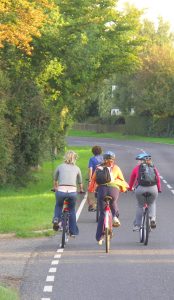
The health hazards posed by air pollution call for immediate action in Bengaluru
By Anish Rajesh and Merlin Francis
Bengaluru is infamous for its traffic jams and poor road conditions, which lead to road accidents and ‘pot-hole deaths’. But there is another reason why its current transport system is dangerous: air pollution.
Vehicles contribute to around 68% of Bengaluru’s particulate matter of 10 microns or less (PM10) emissions. The Center for Study of Science, Technology and Policy’s (CSTEP’s) study indicates that PM10 could increase by at least 12% by 2024 compared with the 2019 levels if we do not implement immediate measures. According to a Green Peace and IQ Air report, at least 12,000 lives lost were attributed to pollution-related illnesses in 2020. Emissions released from vehicular movement such as carbon dioxide, carbon monoxide, nitrogen oxide, sulfur dioxide, volatile organic compounds, and particulate matter are linked to heart diseases, lung cancer, and other acute respiratory illnesses.
Bengaluru is, therefore, looking at innovative ways to end its air pollution woes by putting people at the centre of the solution.
But First, How Do Vehicles Pollute?
There are two main ways in which vehicles contribute to air pollution in Bengaluru: tailpipe emissions and resuspension of dust.
Traffic jams and slow-moving traffic tend to increase tailpipe emissions from vehicles. During peak hours in the city, pollution levels are well above the Central Pollution Control Board (CPCB) standards.
Another study by CSTEP found that unpaved roads were also a major contributor to particulate matter in Bengaluru. The study indicates that resuspension of road dust occurs during vehicular movement and contributes 17% to the city’s total PM10 levels.

Changing How We Move
There is global recognition of the magnitude of the health crisis due to air pollution, and citizens, start-ups, NGOs, and the Government are attempting various solutions to check rising pollution in the city.
Shifting the mode of transport, shifting to electric vehicles, and deploying technology (such as diesel particulate filters) and standards (pollution under control certificates) are some measures that promise to reduce air pollution.
Apart from these measures, we need a humanistic approach towards how cities are designed to meet air pollution standards and address the climate crisis. This is where active mobility comes in.
Active Mobility = Zero Emissions Mobility
The Directorate of Urban Land Transport (DULT) released the Active Mobility Bill earlier this year. The bill promotes sustainable urban mobility. Karnataka is the first state in India to introduce such a ground-breaking bill that puts the safety of pedestrians and cyclists at the heart of mobility and ensures equitable access to road infrastructure. One of the key features of the bill is the ‘people-centric’ design of urban streets—providing cycling tracks and good, clear, and accessible footpaths. It mandates that all new streets have pedestrian and cycling facilities to ensure a safe pathway for an eco-friendly commute. The bill can help address vehicular pollution by ensuring that sustainable modes of transport are convenient and seamlessly connected.
The bill also explores how shared micro-mobility vehicles, such as public bike sharing, can address the last-mile connectivity gaps that are a key barrier to citizens shifting to public transport. An earlier study by the Indian Institute of Science looked at how we could see a significant reduction in air pollution by shifting to public transport and electrifying the transport sector in Bengaluru. Recent data from the National Family and Health Survey revealed that just about 8% of the Indian population owned cars. More than half the population still use bicycles or two-wheelers for travel. However, traditional designs and plans of cities have cars at the centre of mobility plans.
The Active Mobility Bill signals a shift in thinking on how cities are designed, bringing the focus back to the movement of people, not cars. Studies show that even if half the number of motorised two- and four-wheelers can be substituted by cycles, India could save almost INR 27 billion in fuel import and INR 241 billion in pollution control funds. This shift is in line with changes being made across the world.
Countries in Africa, Central America, and Europe are experimenting with new urban models that can improve access to roads while checking air and noise pollution. Zambia’s ten-year plan to reduce greenhouse gas emissions includes investments in high-quality walking and cycling infrastructure. Rwanda introduced a car-free zone in its central business district to reduce air pollution. Ethiopia launched a national policy encouraging non-motorised transport to meet WHO’s air quality standards 350 days a year.
Recognising the benefits of non-motorised transport in improving air quality and addressing climate change, the United National Environment Programme developed the Share the Road Programme to support cities and stakeholders in developing countries to invest in infrastructure that supports walking and cycling.
Bengaluru measured over 214 days in the ‘good’ AQI levels in 2020 and 208 days in 2021, thanks to reduced traffic and commercial activities during the lockdown. However, pollution levels shot back up as soon as the lockdown was lifted and commuting resumed. With active participation from its citizens and effective implementation of policies, the garden city of India could become the trendsetter for active mobility in India.
Anish Rajesh is a former intern at CSTEP and a student of Symbiosis College, and Merlin Francis is Communication Manager (Content) at CSTEP.

Have you registered for India’s biggest event on Air Pollution? The 4th edition of The India Clean Air Summit 2022 is on 23-26 Aug. Register today to participate in discussions that are aimed at finding scientific solutions to improve India’s air quality.
Find more details here: https://cstep.in/event-details.php?id=2042
More About Publication |
|
|---|---|
| Date | 17 August 2022 |
| Contributors | |
| Publisher | |
| Related Areas | |
| Tags | |
Get in touch with us at
cpe@cstep.in